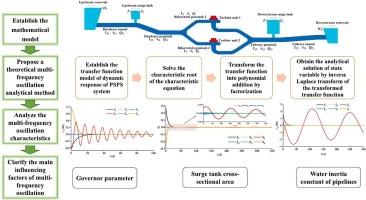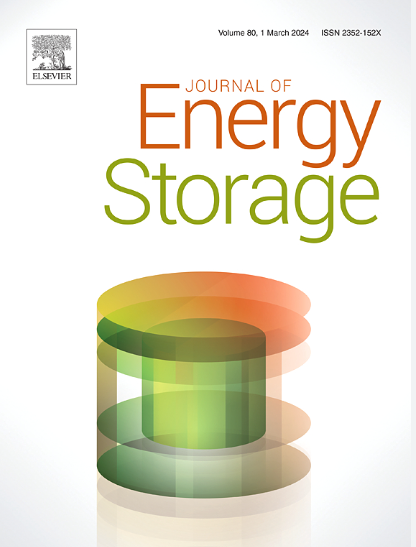基于理论分析方法的抽水蓄能电站多频振荡特性和稳定性
IF 8.9
2区 工程技术
Q1 ENERGY & FUELS
引用次数: 0
摘要
抽水蓄能电站是一个复杂的水力-机械-电力耦合系统。子系统间的耦合效应导致抽水蓄能电站呈现多频振荡特性,给稳定运行带来挑战。然而,广泛使用的特征值分析、水力振动分析和傅立叶变换方法无法全面区分和量化抽水蓄能电站的多频振荡特性。本研究旨在提出一种理论分析方法,以全面研究多频振荡特性及其主要影响因素。首先,建立了带有上下游涌流槽的抽水蓄能电站数学模型。然后,介绍了推导动态响应理论公式的多频振荡方法,并通过数值模拟进行了验证。准确识别了动态响应中的主要振荡。结果表明,系统应由六个频率振荡(S1 - S6)组成,转速的动态响应由主波和尾波组成。主波由 S1 和 S6 振荡决定,尾波由 S3 振荡决定。最后,研究了影响多频振荡的主要因素。调速器参数和水闸水惯性极大地影响了 S1 和 S6 振荡,进而影响了主波。尾水渠隧洞水惯性对 S3 振荡和尾波有显著影响。总之,所提出的方法不仅加深了我们对水力-机械-电气耦合多频振荡的理解,而且对确保抽水蓄能电站的稳定运行具有重要的工程价值。本文章由计算机程序翻译,如有差异,请以英文原文为准。

Multi-frequency oscillation characteristics and stability of the pumped storage power station based on a theoretical analytical method
The pumped storage power station is a complex hydraulic-mechanical-electric coupling system. The coupling effect between subsystems causes the pumped storage power stations to exhibit multi-frequency oscillation characteristics, making stable operation challenging. However, the widely-used eigenvalue analysis, hydraulic vibration analysis, and the Fourier transform methods cannot comprehensively distinguish and quantify the multi-frequency oscillation characteristics of pumped storage power stations. This study aimed to propose a theoretical analysis method to comprehensively investigate the multi-frequency oscillation characteristics and their main influencing factors. First, the mathematical model of a pumped storage power station with upstream and downstream surge tanks was established. Then, a multi-frequency oscillation method for deriving the theoretical formula for the dynamic response was introduced, and verified via numerical simulation. The dominant oscillations in the dynamic response were accurately identified. The results showed that the system was supposed by six frequency oscillations (S1 - S6), and the dynamic response of the rotational speed consisted of a major wave and a tail wave. The major wave was determined by the S1 and S6 oscillations, and the tail wave was determined by the S3 oscillation. Finally, the main factors influencing the multi-frequency oscillations were investigated. The governor parameters and penstock water inertia significantly influenced the S1 and S6 oscillations and thus the major wave. The tailrace tunnel water inertia significantly influenced the S3 oscillation and thus the tail wave. Overall, the proposed method not only enhances our understanding of hydraulic-mechanical-electric coupling multi-frequency oscillations, but also has important engineering value for ensuring the stable operation of pumped storage power stations.
求助全文
通过发布文献求助,成功后即可免费获取论文全文。
去求助
来源期刊

Journal of energy storage
Energy-Renewable Energy, Sustainability and the Environment
CiteScore
11.80
自引率
24.50%
发文量
2262
审稿时长
69 days
期刊介绍:
Journal of energy storage focusses on all aspects of energy storage, in particular systems integration, electric grid integration, modelling and analysis, novel energy storage technologies, sizing and management strategies, business models for operation of storage systems and energy storage developments worldwide.
 求助内容:
求助内容: 应助结果提醒方式:
应助结果提醒方式:


